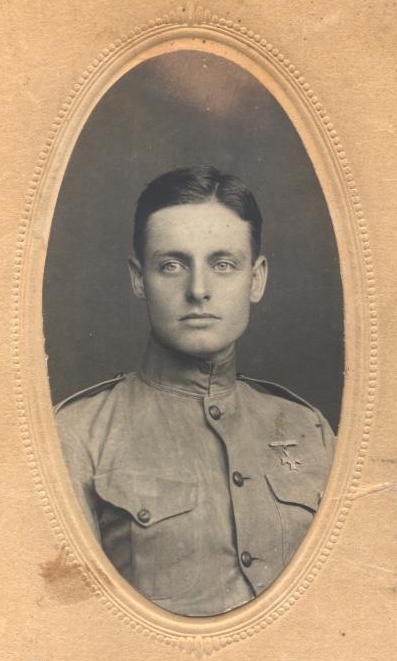
Pvt Clarence Harvey
(Photo courtesy Russell and Susan Harvey)
Pvt Clarence C Harvey, a seagoing Marine, served in the Far East from March 1912 through February 1915 aboard the USS Cincinnati. From Harvey’s autobiography we learn he was born in Iowa, but moved west with his family to farm. We know as a young boy he wanted to attend West Point, but never had the opportunity to apply as he only had a 10th grade education. Although he could have become a farmer, he chose upon reaching manhood, to enlist in the Marines at their recruiting office in Denver. From Denver he was sent to Mare Island for training before sailing for the Philippines March 1912 aboard the USAT Thomas.

USS Rainbow
Almost immediately upon arriving at Manila, Harvey must have been tagged for expeditionary duty. With the riots just ending in Peking, he was quickly sent to North China aboard the collier USS Abarenda. Off of the Taku Bar he transferred to the USS Rainbow, shown here, probably as part of a draft to relieve some of the Marines who had been aboard the Rainbow since Oct 1911. The Rainbow with several Marine companies on board, cruised the coast of China in anticipation of serious threats against American citizens during the Chinese Revolution. After spending several months onboard the Rainbow, Harvey transferred along with a small number of his fellow Marines to a new home.
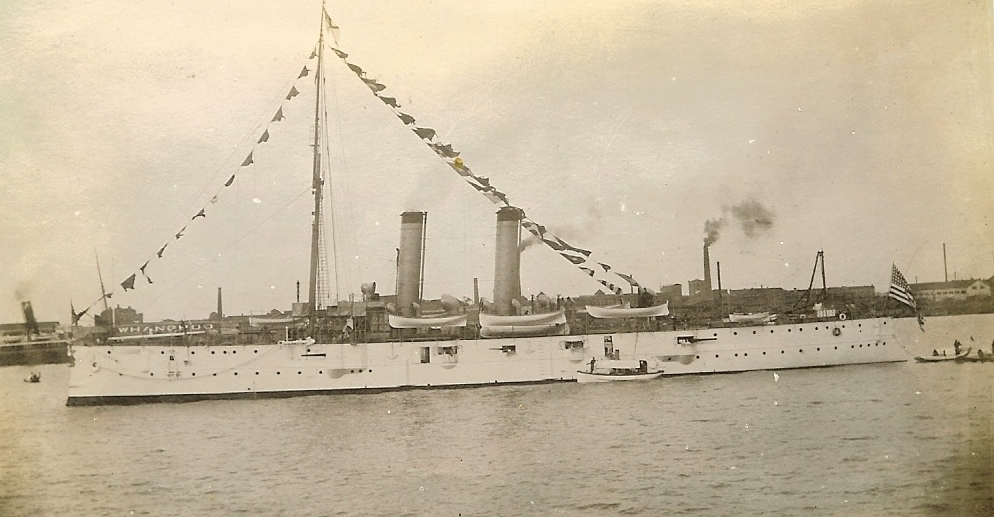
The USS Cincinnati off Shanghai
His new home, for almost three years, was the protected cruiser USS Cincinnati, commissioned 1894, already a veteran of the Spanish-American War, she had been cruising the Far East since Dec 1911. According to John D. Alden’s book “The American Steel Navy” the Cincinnati was 300 feet long, with a displacement of 3,213 tons and a draft of 18 feet. Which means she could operate on the Yangtze River as far as port of Hankow (in high water)…almost 600 miles from Woosung, the entry port to Shanghai. For armament the Cincinnati had 1 six inch gun and 10 five inch guns as well as 8 six pounders, one of which Harvey served as gun captain. In addition, the ship had 2 Gatling guns for close in work. Perhaps she was already outdated when compared to some of the newer European ships operating along China’s coast, but she was more than a match for almost anything the Chinese could throw at her.

The Cincinnati was one of the last US ships to sport a bow figure…in this case winged victory holding aloft an eagle. Harvey recorded several views in his album of this stunning figure.

A section of Marines from the USS Cincinnati
When Harvey joined the Cincinnati he was part of a Marine detachment of about 36 men under 1Lt. Harold Parsons. Harvey wrote the mission of the Marines aboard the ship was simply to “protect American interests, mainly the Standard Oil Company, American missionaries, and [United States] counsels which were at the many cities along the Yangtze.” Most of the Marines he embarked with stayed with him through his whole cruise expect for those that got sick or got the “straight kick” for bad behavior. Here several members of the detachment pose for the camera.
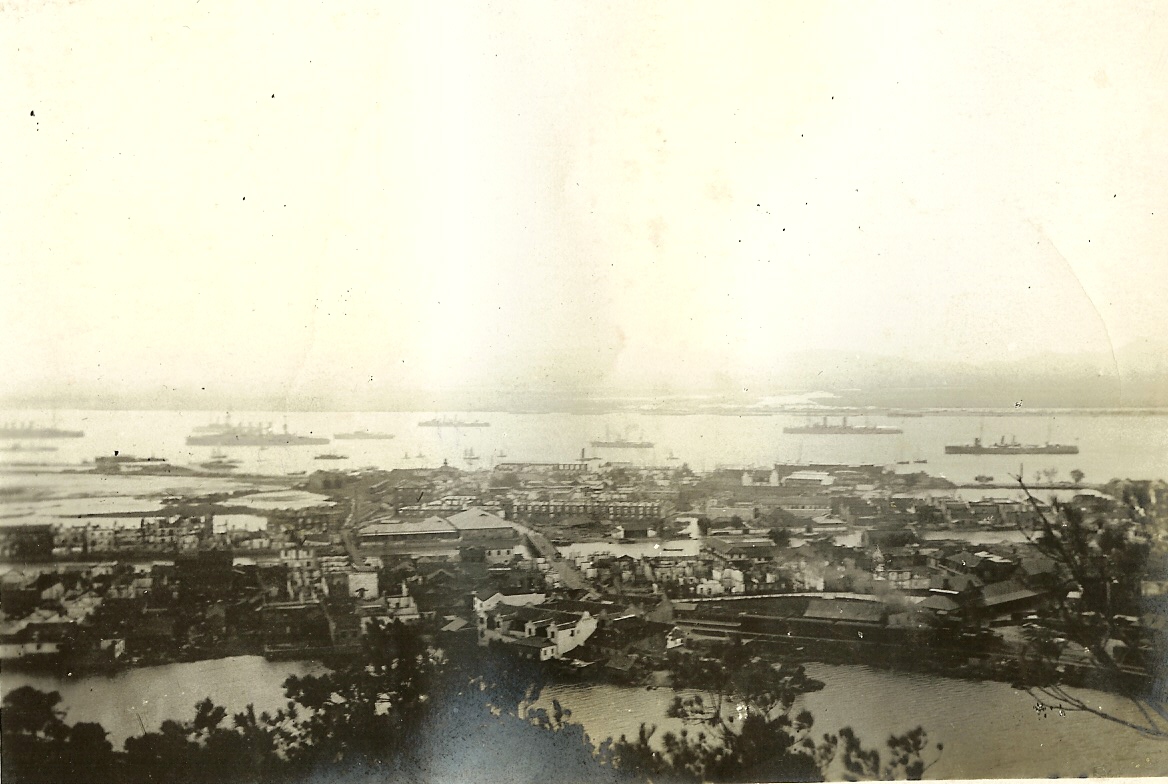
Nanking
Along with patrolling the Yangtze, the Cincinnati could be expected to conduct patrols along China’s entire coastline, with stops in Japan and extensive training periods around Manila Bay. I really enjoy this picture, as it typifies for me the ideal side of life for an Asiatic sailor. This is the port of Nanking along the Yangtze. Here members of the ship’s crew looks down upon the port, steamers and foreign warships riding at anchor….must have been pretty exotic to a farm boy from Colorado. This sterile view masks the disease, civil strife and crushing poverty these men must have witnessed in each port.
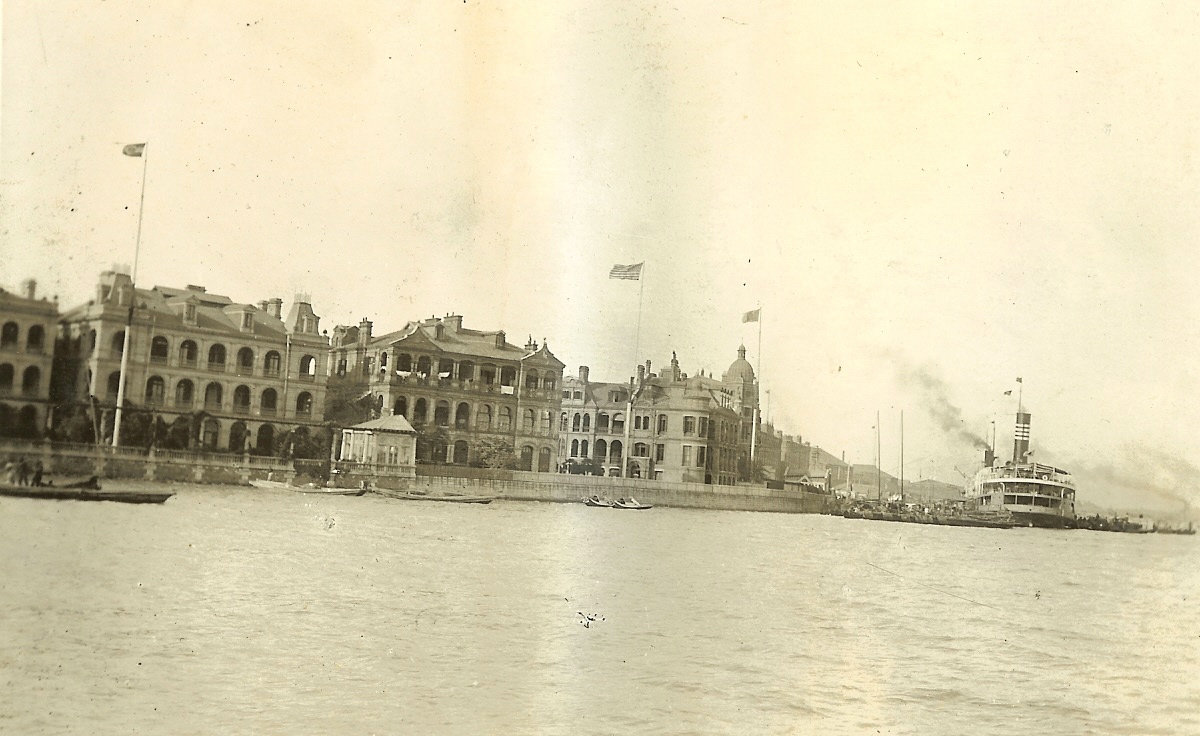
The Shanghai Bund
Even at the time Harvey passed through Shanghai, the city enjoyed a reputation for excitement with its bustling business community, saloons, social clubs and numerous European luxuries not found elsewhere in China. It was also during the pre-WWI years when a certain class of American and European “actresses” would do the China circuit by setting up “performances” at ports where sailors from the great powers were expected to visit…Shanghai and the Yangtze concessions in the winter…Chefoo and Tsingtao in the summer. However, his family confirmed neither this kind of woman or strong drink appealed to Pvt Harvey. Here we see the Shanghai Bund with German, American and Japanese flags flying above their respective consulates. Beyond the City and back up the Wangpoo lies the Yangtze River.
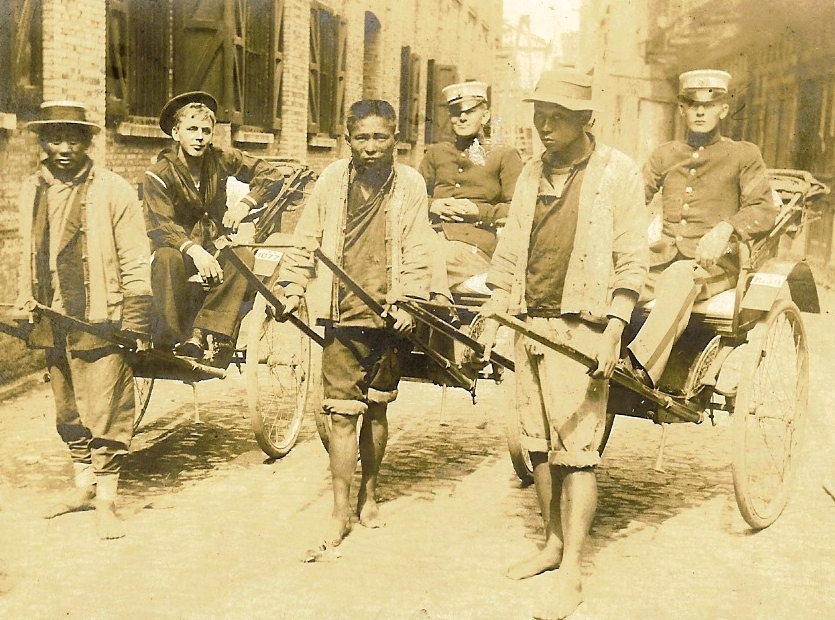
Fenton Tucker's picture postcard home. He appears on the right.
This image did not come from the Harvey collection, but fits nicely here. Corporal Fenton Tucker of the USS Galveston, a “peace cruiser” that sailed alongside the Cincinnati for much of Harvey’s tour sent this PPC home on 23 June 1914. He noted Marines and sailors from the Saratoga, Cincinnati and Galveston paraded through the city on Decoration Day. He went on to label this card “The morning of the night before.” He further added “Got some bad water in Shanghai Ha Ha.” It looks like the sailor did.
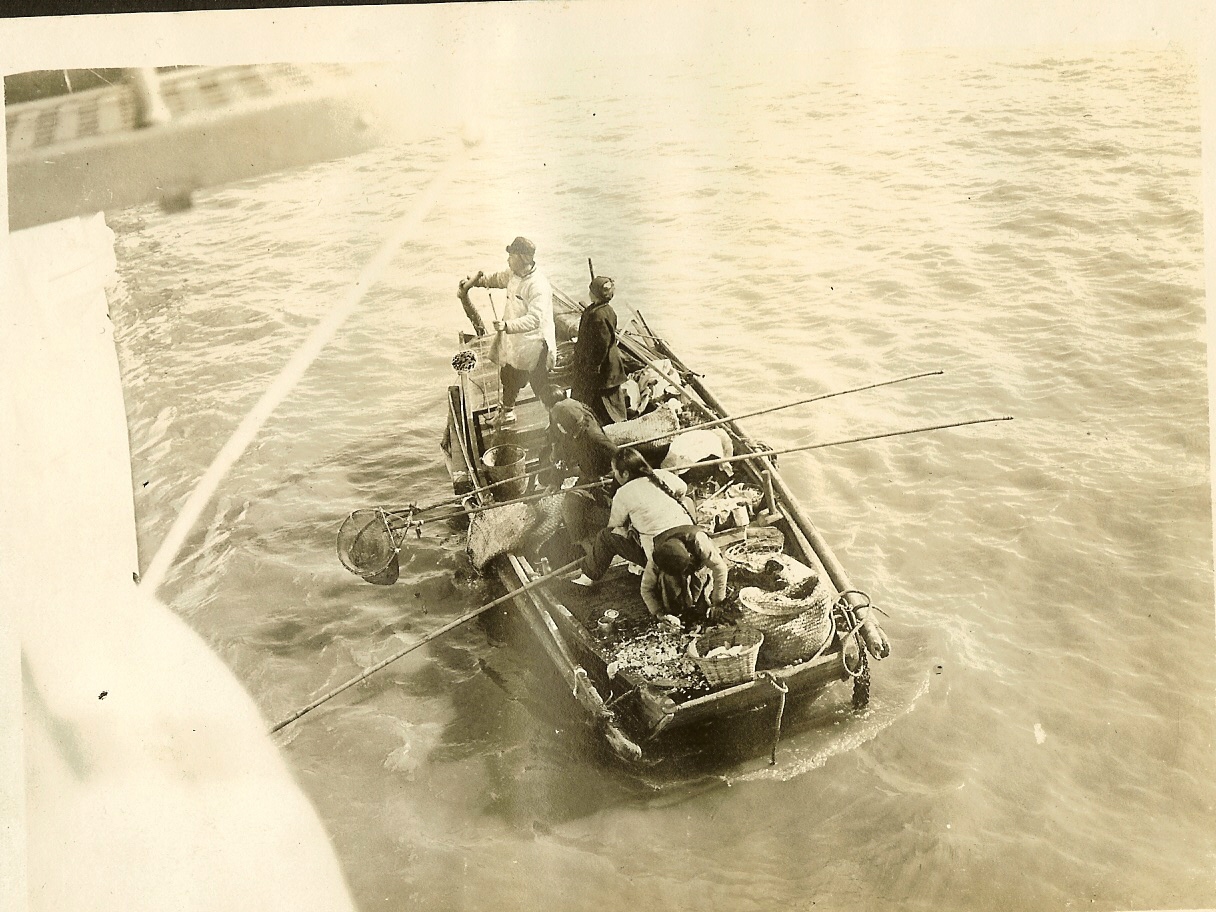
"Slop Shute Mary" alongside the USS Cinicinnati
In the movie The Sand Pebbles, there was a scene where Hollman (Steve McQueen), on observing how Chinese crewmen on the USS San Pablo seemed to do all the manual labor, asked Frenchy (Richard Attenborough) “How did this thing get started anyway?” If I remember correctly, Attenborough explained, initially the Chinese collected the ships garbage, and then worked their way on the ship as de-facto crew members. This photo, Harvey labeled “Slop Shute Mary”, shows a Chinese family collecting the garbage off the Cincinnati in hopes of finding useable food to eat or resell. Normally the crews hated the approach of these ship as they brought with them large number of flies.
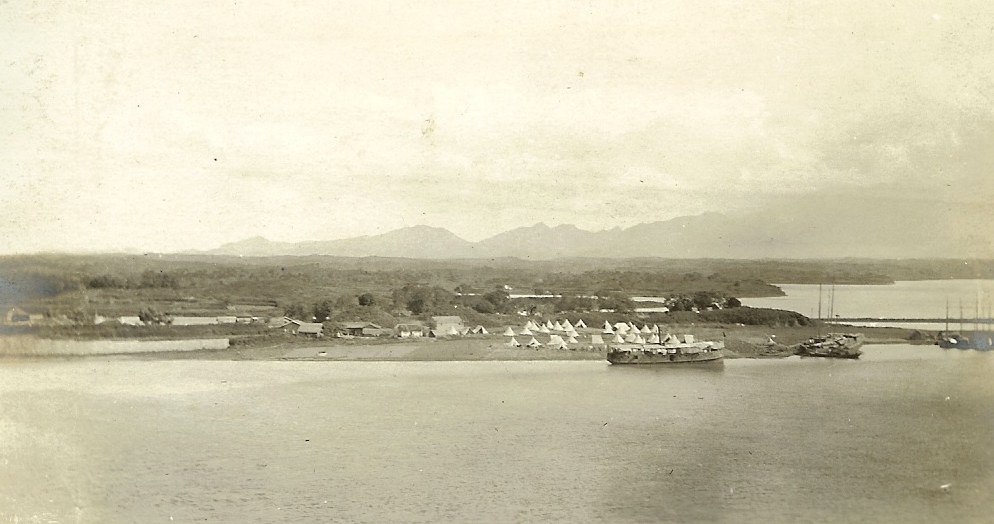
The Rebel camp at Kuikiang
Probably one of the biggest events Harvey witnessed during his Far Eastern cruise was an uprising lead by Sun Yat Sen’s Nationalist forces during the summer of 1913. Despite a revolution that ended Imperial rule, southern Chinese nationalists lead by Sun felt the Republic’s President Yuan Su-ka’I was nothing more than an autocrat in “republican clothing.” Naming Nanking as his capital, Sun’s forces controlled several cities along the Yangtze. As this uprising progressed, threats were made against foreigners and that in turn brought requests for the Marines. On the 25th of July the Cincinnati left Nanking and sailed some 300 miles up river to Kuikiang with orders to land its Marines if necessary. Upon arrival, the Cincinnati’s Captain consulted several other foreign naval commanders whose ships were at Kuikiang, and agreed the situation would not benefit from the landing of Marines. For several days the Cincinnati stood off a rebel camp until assured no harm would come to any American in the area…this image shows the rebel’s camp at Kuikiang.
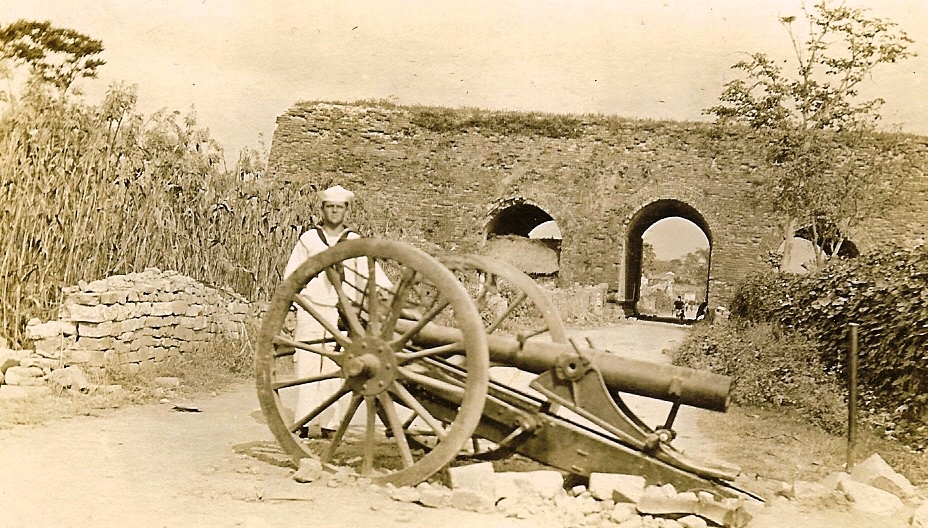
A sailor inspects a wrecked gun after the fighting for Nanking
After three days, a new threat emerged as federal forces loyal to the Government laid siege to Nanking. The cruiser raced back down river to watch the ensuring battle for the city. With the Cincinnati anchored in mid-channel, Harvey would later write both sides sent artillery “across our bow and stern and many cases they [shells] whistled real close….our ships were in danger many times and warnings had to be sent to the belligerents to be more careful of their firing as many rifle bullets struck us, and one sailor was shot.” At the end of August the Federals had reduced rebel defenses to a level sufficient to allow them to assault the city. Harvey went on to write “one night we were ordered to stand by to land as we knew the city was going to fall and we were told to see no American was molested. The rebels were setting fire to the city in a dozen places and preparing to abandon the city. By midnight the city was a mass of flames and coupled with the hurling of shrapnel and the rattle of machinegun and rifle fire it was a pretty sight.”
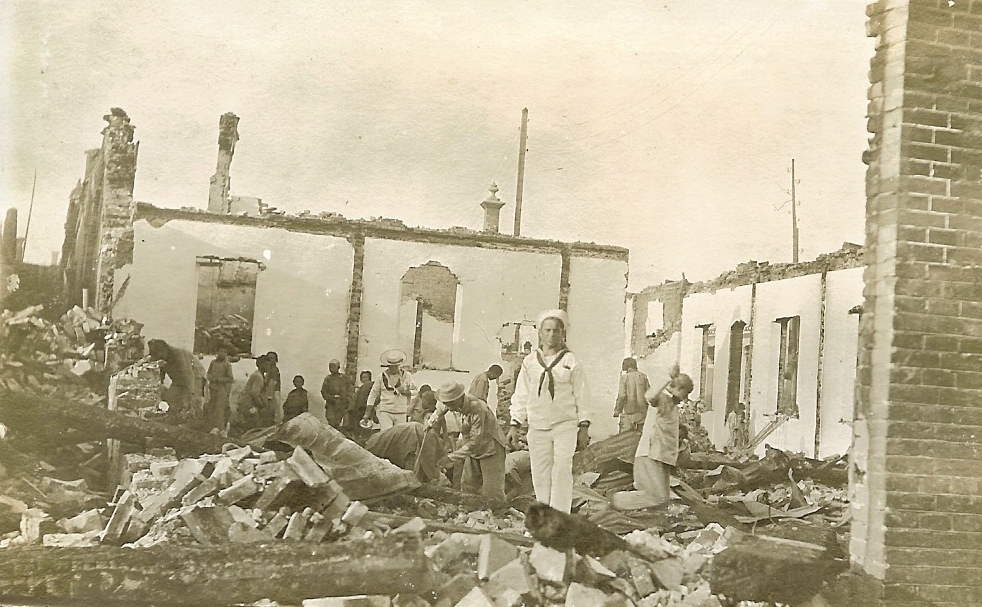
Inspecting the remains of the Nanking waterfront
“The next morning I obtained a shore leave and had an excellent opportunity to view the ruins and observe the victorious [federal] army. There was confusion everywhere and troops were having a time dealing with looters and doing a little looting themselves. The looters were beheaded or shot on the spot and in many cases not buried for days.” Here we see American and British sailors joining Chinese citizens to pick through the ruins of the Nanking Waterfront.
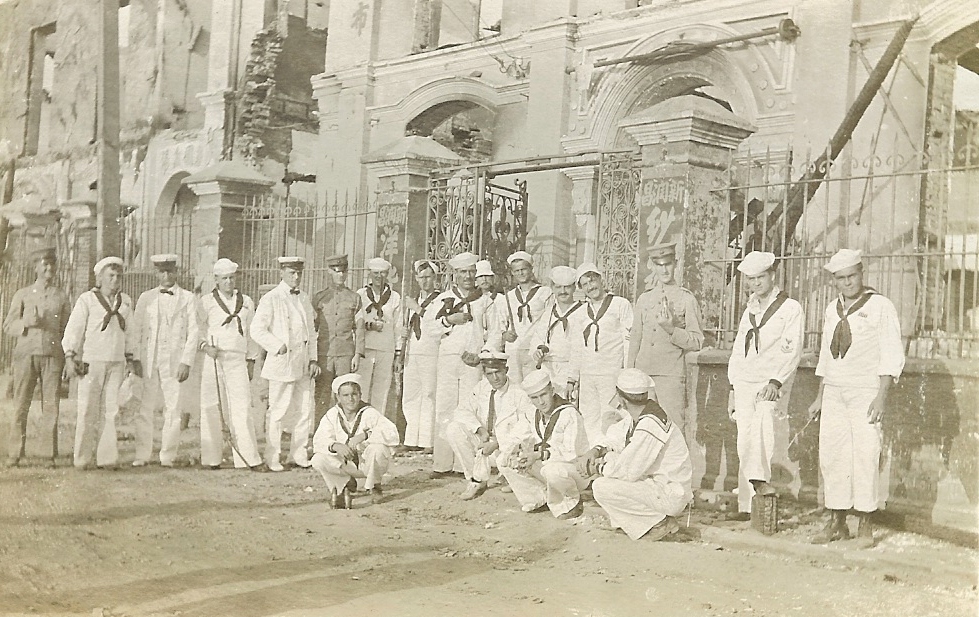
Sailors and Marines displaying their "battlefield" pickups following the fighting in Nanking
This image shows Sailors and Marines displaying their battlefield “pick ups” after waking around the ruined city….note, possibly another ship’s mascot? Amazingly, I bought this same image several years earlier from a collection of an unidentified US Asiatic sailor….so these shots must have been taken by someone in that shore leave party and distributed to interested shipmates.

The Saratoga at Shanghai
The next series of images covers a few of the ships the Cincinnati encountered during it years in the Orient. I think for a portion of Pvt Harvey’s cruise, the armored cruiser USS Saratoga (Ex-USS New York), seen at Shanghai, was the Flagship of the US Asiatic Fleet. Years later the decommissioned Saratoga, then the ex-USS Rochester was scuttled in the Philippines as Japanese forces approached Olongapo at the start of WWII.

Here we see two US Submarines in Manila By. I believe the Navy had three subs stationed in the Philippines prior to WWI.
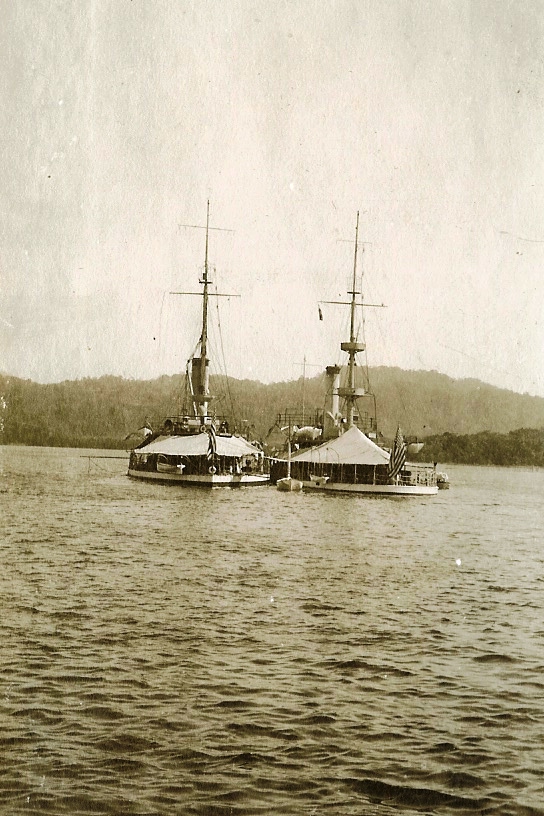
The USS Monterey and USS Monadnock near Shanghai
These are the monitors USS Monterey and USS Monadnock at a Yangtze anchorage. By the turn of the century monitors proved unpopular with the Navy and were relegated to serving as station ships, as shown here. Both these vessels were scrapped in the early 1920s.
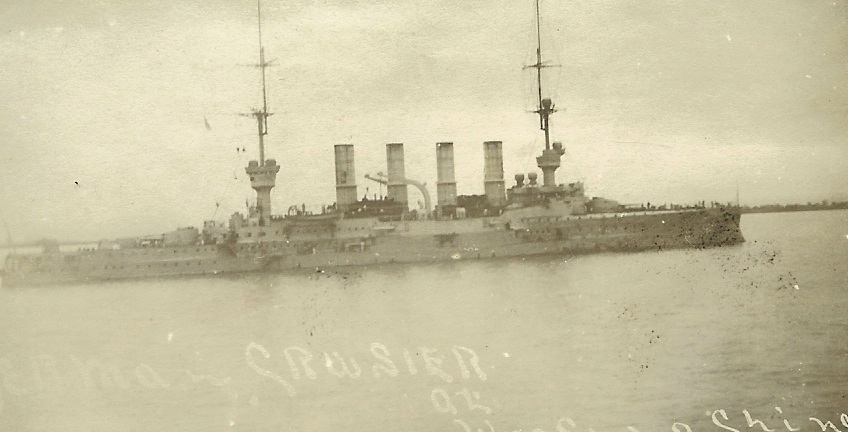
SMS Scharnhorst
Despite recording a number of US and foreign naval ships in his album, it was the sight of German Battle Cruiser Scharnhorst and other warships of the German Far Eastern Squadron that remained on his mind long after he left China. These ships were sunk in the early months of WWI. In Dec of 1914 he wrote his mother “I read in the China Press today the sinking of three German Cruisers, Scharnhorst, Gneisenau and Leipzig. I have seen all three of these boats. The Scharnhorst was at Nanking with us in 1913 and we were stationed here in Shanghai with the Leipzig many a time. The Gneisenau I saw in Japan in June. Many of the officers and men of these ships I have seen aboard the Cincinnati….this war must be dreadful.” This is a private photo taken of the Scharnhorst off Woosung. It is interesting that as WWI loomed the Cincinnati was at Chefoo near the German colony of Tsingtao and steamed south, away from the war zone, encountering in his words “…the English Torpedo Flotilla (hostile).”
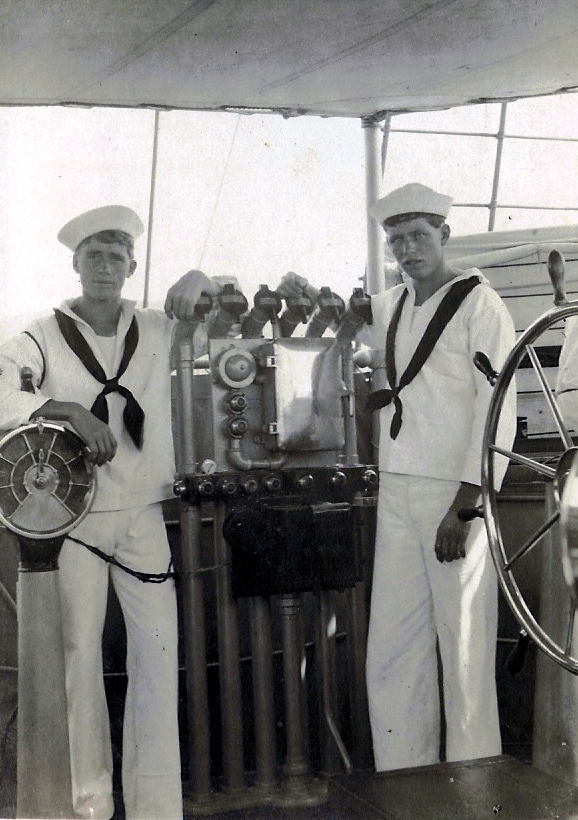
The album is also filled with a number of shots of sailors and marines performing their daily duties. Here are sailors Helgren and Devoe on the bridge of the Cincinnati.
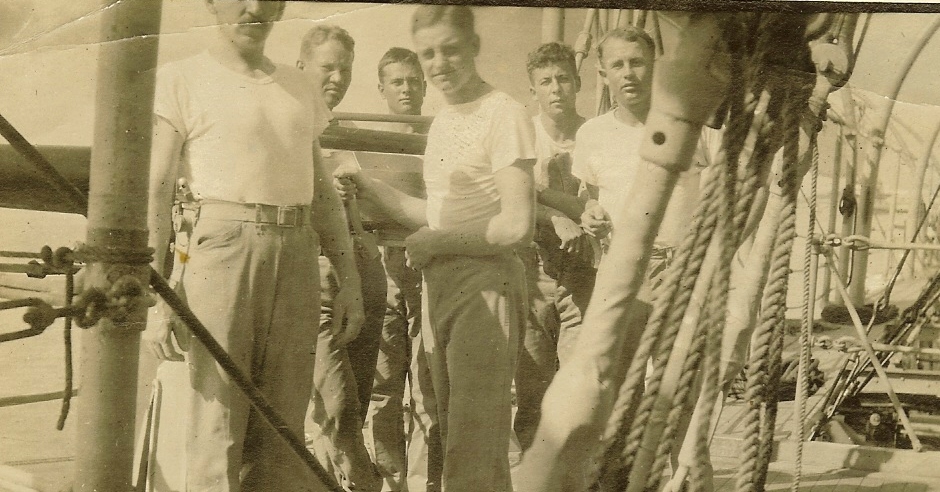
Harvey's Gun Crew
As noted above Harvey was a gun captain for a 6 pounder and wrote to his mother of the results of his gunnery efforts. On the back of this picture he noted “six pounder No 3 Ten shots eight hits Kline 1st Pointer Johnson 2nd Pointer Harvey loader (actg Gun Captain).” On 2 Dec 1914 he recorded “copped Navy “E” at this practice…..4 shots 4 hits 14 seconds.”
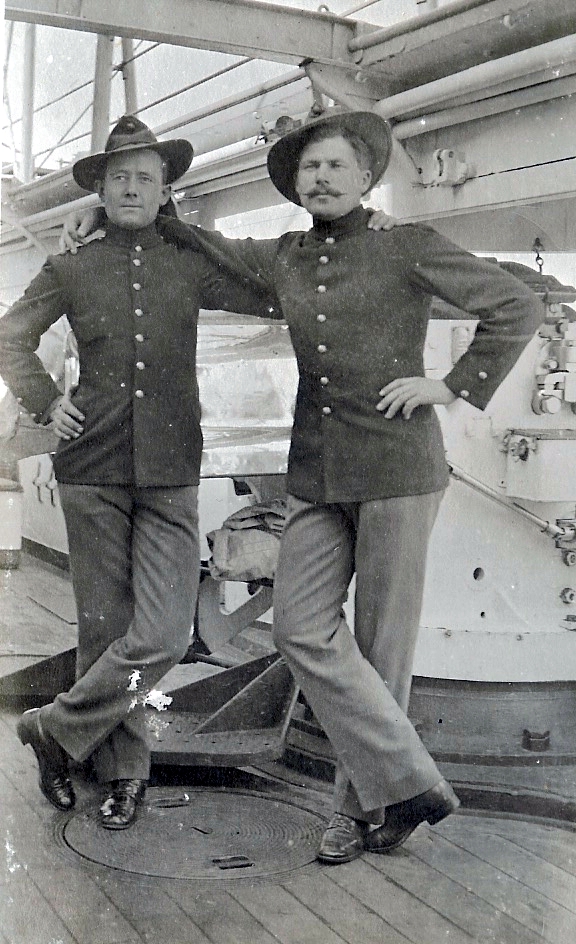
A favorite part of the album is a series of pictures of various Marines on the Cincinnati in different uniform combinations. Harvey wrote in Dec of 1914 that since the uniform regulations changed he would be compelled to get all new uniforms and on this cruise already had to carry many unnecessary items including the phased out full dress uniform. As for his old uniforms…he said he would be forced to throw them away including a brand new blue overcoat!
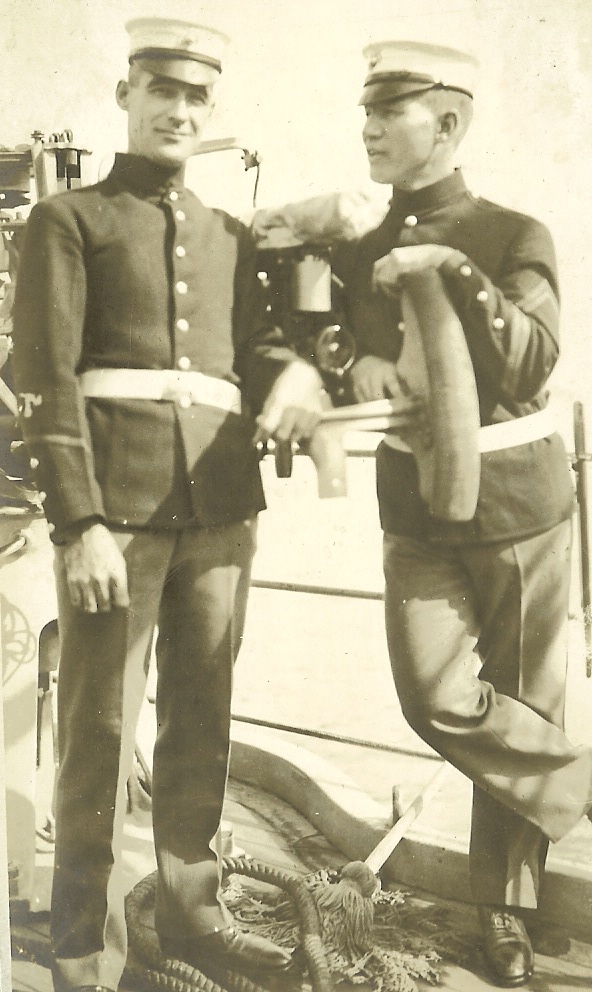
Fitz and Proctor
James Fitzgerald (L) rose to become a Sgt on the Cincinnati until May of 1913 when he was picked up as drunk and unfit for duty and was reduced to Corporal and then Pvt in the same month. He was transferred out to Olongapo in November of that year. On the right Clarence Proctor (R) who despite some minor behavior problems, became a lifer and managed to retire a Sgt Major.
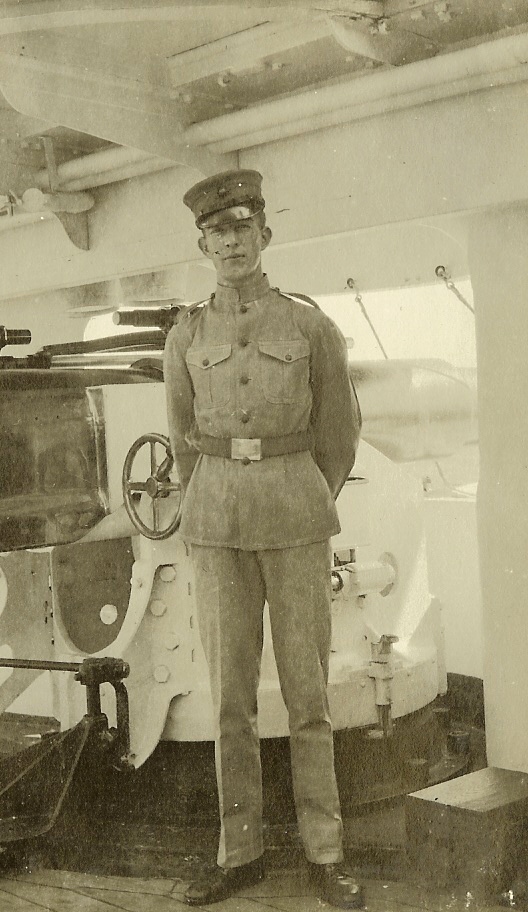
Scotty Maclellan
“Scotty” Maclellan in summer khaki, with duty belt, is seen standing beside one of the ship’s five inch guns. At the time this image was taken he may have been performing duty as an orderly. In October of 1914 he was appointed as a Sgt on the Cincinnati. The rolls show he stayed for another tour and was discharged in 1920, still a Sgt. Maclellan re-enlisted in 1921, and was sent down to Quantico to serve in a HQ Company under Sgt Major Clarence Proctor!
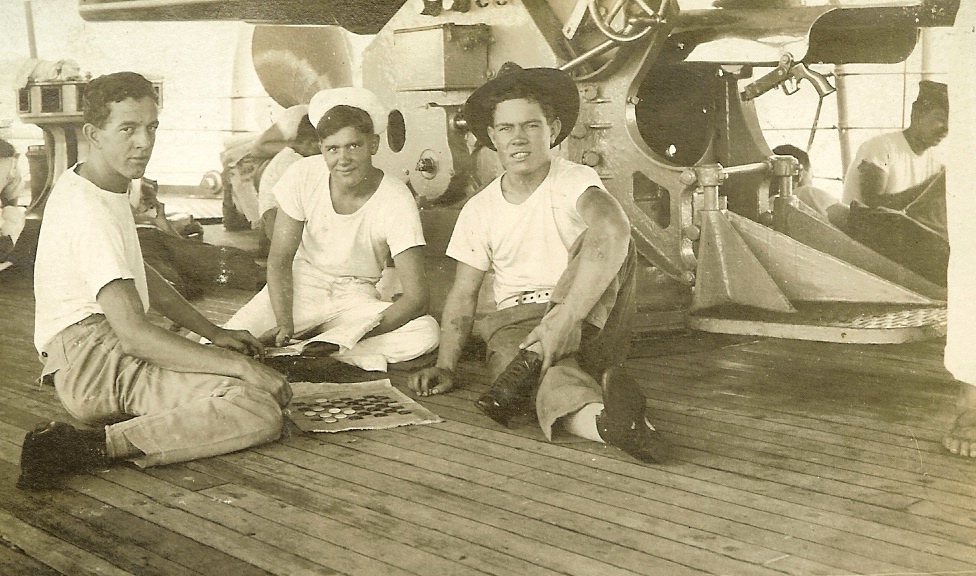
A game of checkers on the forecastle
A former seagoing Marine who was in charge of the Marine Detachment of a Heavy Cruiser recently told me it took a certain kind of Marine to enjoy sea duty. In his case, he loved it. Harvey may have initially as well, but after almost three years he wrote “My, I surely will be glad to get off the Cincinnati. I did not enlist to spend my whole cruise aboard ship but I was almost mistaken.” He further noted that since the air below decks was so foul, he spent almost every night sleeping on deck wrapped in a blanket and a tarp….regardless of rain, snow, or bullets. Sometimes boredom was the enemy. A number of photos show crew members relaxing around the ship or playing cards. Here we see several crew members passing their time playing checkers.
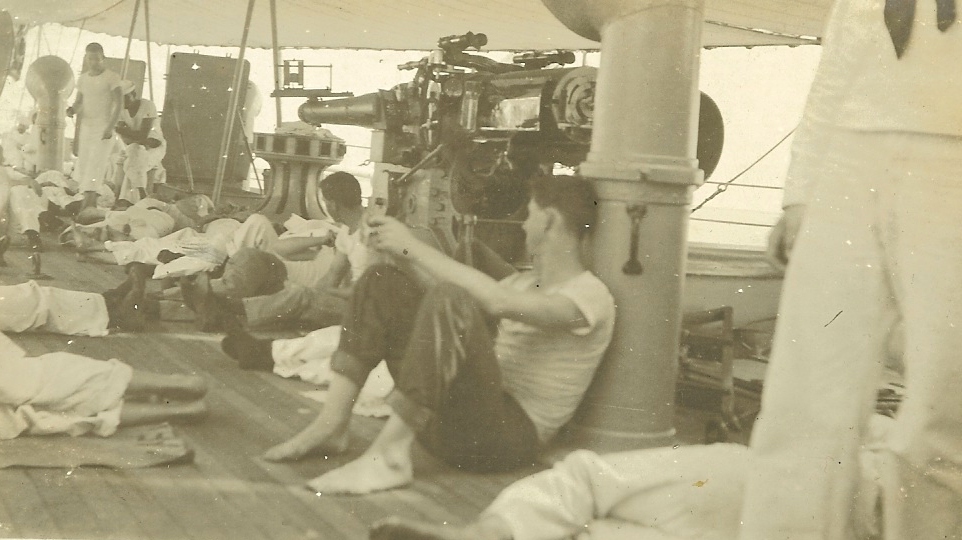
Trying to beat the heat while on the forecastle
And napping under an awning on the forecastle. The summer heat along the Yangtze was described by a US Counsel serving at Hankow as “sub tropical” and “torrid” with very high temperatures and humidity.

Naval Landing Party training in Shanghai
Of course crew members looked forward to breaking their daily shipboard routines with either land based training or shore leave. Here we have several sailors of the ship’s landing party with some type of bi-pod mounted weapon, Shanghai (c.1912-14).
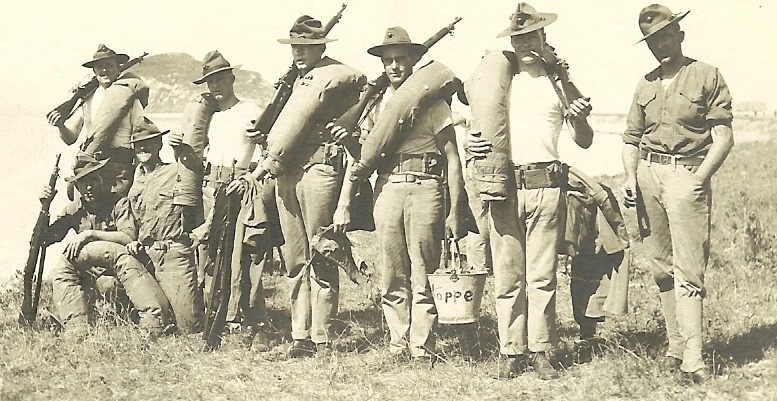
Marines in camp on Kentucky Island, c.1912
Harvey records his Marine Detachment periodically practiced landing operations as well as marksmanship qualification in China and the Philippines. Periodically they would join other Marines from the Asiatic Fleet in a camp to practice their field skills…usually during the summer months. For this purpose, one of the sites the Marines utilized was Kentucky Island, off Chefoo.
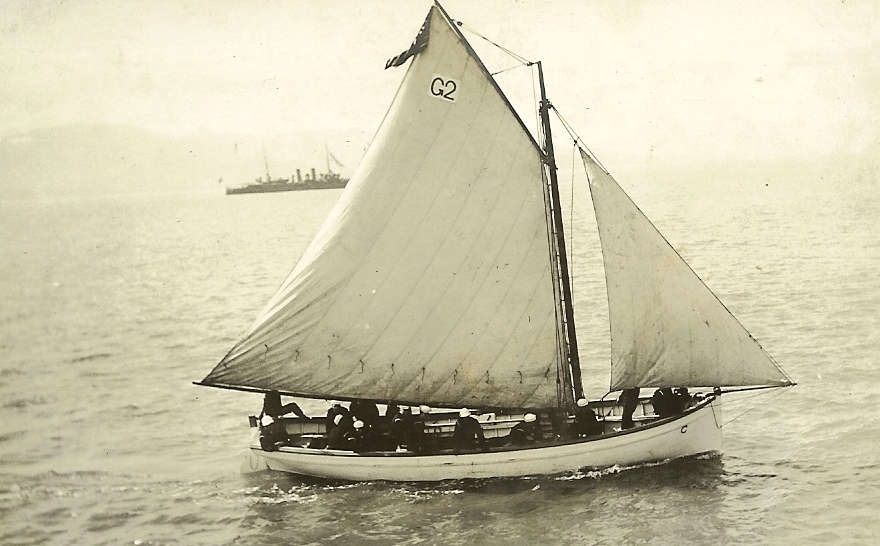
Off Chefoo
Along with training there were opportunities for swimming, organized sporting events, sailing or rowing contests between other ships of the Asiatic Fleet…all well documented in the album. Here we see one of the Cincinnati’s boats rigged for sail near Chefoo.

Sightseeing on the Peak, Hong Kong
Of course sightseeing was popular, with occasional 48 hour liberty. Several members of the Cincinnati’s crew are photographed atop Victoria Peak in Hong Kong. I believe the regulations at the time forbid seagoing Marines and sailors from having civilian clothes while in foreign waters. Despite the restrictions, Harvey, in a letter home noted a number of men had civilian clothes that they hid all over the ship. In fact, he wrote the men were considering stashing a threshing machine on the ship, but were having trouble finding a location to hide it!

Pvt Harvey on the deck of the USS Cincinnati
Toward the end of Harvey’s cruise he wrote his mother he hoped to take the civil service exam and receive his discharge. He returned to the states March 1915 and served the remainder of his time at Mare Island alongside a number of his fellow shipmates. When we next hear of him in 1917, he is in training with the Santa Fe Railroad as a telegrapher and had fallen in love with a young woman. With the US entry into WWI he faced a dilemma, he wanted to reenlist in the Marines but was still too new to his good railroad job to walk away and besides he wanted to marry first. Unfortunately, he was drafted into the Army before he could get married and therefore as a draftee, ineligible for the Marines. But while in the Army was able to finally marry the woman he had so fallen with. During stateside training he quickly rose from a Pvt to a 1st Sgt, and while in France received a Commission. He served with the 90th Division. A reservist, he was reactivated for service during WWII. His son described him as a quiet man who really hated war and yet served his country proudly. Currently, his daughter-in-Law has published his letters home while he served with the AEF. On his return from Asia, Pvt Harvey sent the post card below from Hawaii to his future stateside address at Mare Island. I guess he was trying to see if his transport would beat the mail ship home.
